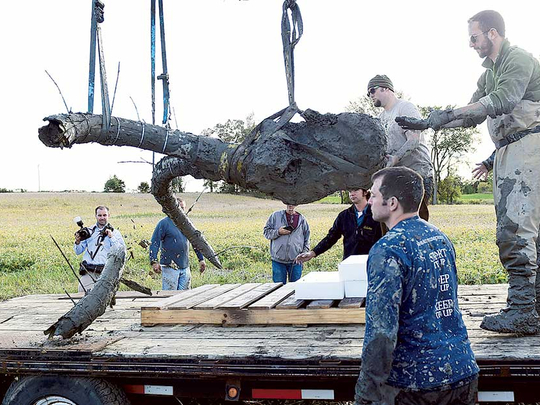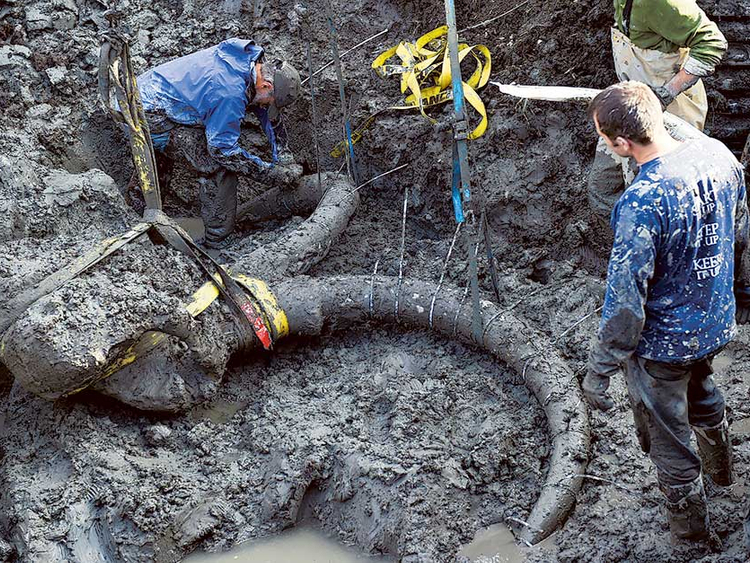
LIMA TOWNSHIP, Michigan: On Monday, James Bristle and a friend were digging in his soybean field when they unearthed what looked like a bent fence post, caked with mud. Instead, it was part of a pelvis from an ancient woolly mammoth that lived up to 15,000 years ago.
Study of the bones may shed light on when humans arrived in the Americas, a topic of debate among archaeologists.
On Wednesday, University of Michigan professor Daniel Fisher — who had been contacted via the university by Bristle and his friends — was able to go out and confirm the find.
A team of paleontologists from the University of Michigan and an excavator recovered about 20 per cent of the animal’s skeleton this week in Michigan. Aside from the pelvis, they found the skull and two tusks, along with numerous vertebrae, ribs and both shoulder blades.
“We think that humans were here and may have butchered and stashed the meat so that they could come back later for it,” Fisher said Friday.
Three boulders the size of basketballs found next to the remains may have been used to anchor the carcass in a pond, he said.
“We get calls once or twice a year about new specimens like this,” Fisher told The Washington Post. But they’re usually mastodons. It’s a bit more unusual to find a mammoth, the species more closely related to modern elephants.
After establishing that Bristle could only spare one day for the mammoth extraction, Fisher and his team went into overdrive. On Thursday they were deep in the muck, doing their best to carefully document and extract the bones at top speed.
“We don’t just want to pull the bones and tug everything out of the dirt,” Fisher explained. “We want to get the context for how everything was placed at the site.”
Mammoths and mastodons, another elephant-like creature, were common in North America before disappearing around 11,700 years ago.
Remains of about 300 mastodons and 30 mammoths have been discovered in Michigan, Fisher said, although most of the mammoth finds aren’t as complete as the one in Bristle’s field.
Bristle told the Ann Arbor News he bought the property a couple of months ago. He and his friend were digging to make way for a new natural gas line when they found the odd object.
“We knew it was something that was out of the norm,” Bristle told The Ann Arbor News. “My grandson came over to look at it, he’s 5-years-old, he was speechless.”
The bones will be cleaned and examined by university researchers for cut marks that would indicate human activity, Fisher said.
There are a few things that make this particular mammoth exciting: It’s a very complete skeleton (although it’s missing its hind limbs, feet, and some other assorted parts), compared with most of the mammoths found in Michigan and surrounding areas. And because it’s been carefully extracted by paleontologists, it has the potential to be studied much more thoroughly than bones haphazardly pulled out of the ground.
“We’ll have the potential to say way more about this specimen,” because of the careful excavation, Fisher said.
Already, he believed he sees evidence that humans interacted with the beast.
Fisher doesn’t have quite as much evidence as he’d like to confirm that theory, but he hopes that the bones will yield more information.
“It’s really the landowner’s call now,” he said, explaining that Bristle now owns the bones. Normally, Fisher explained, the university wouldn’t have put resources into excavating remains without some reassurance that they’d be donated for research. But because these were under such a time crunch, Fisher and his colleagues decided to swoop in. He said on Friday that Bristle has yet to give a verdict on the fate of the bones.
“To really make conclusions about these bones and what they mean, we have to make the evidence available for other scientists to study, too,” Fisher said. “And we can’t do that without long-term access to the material.”
— Agencies













